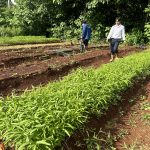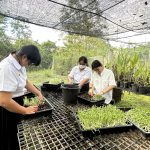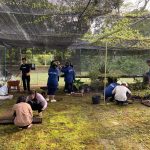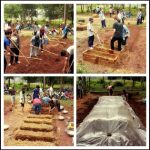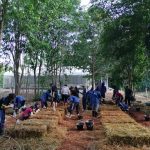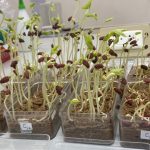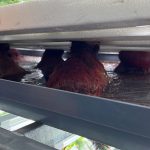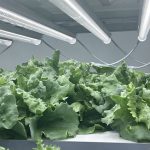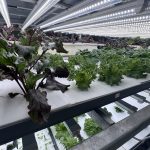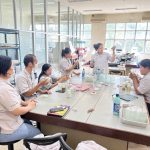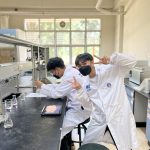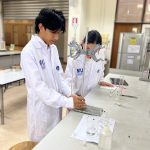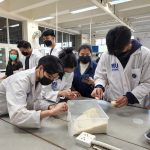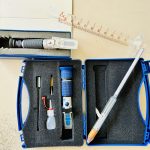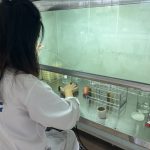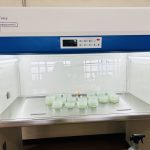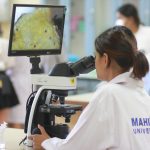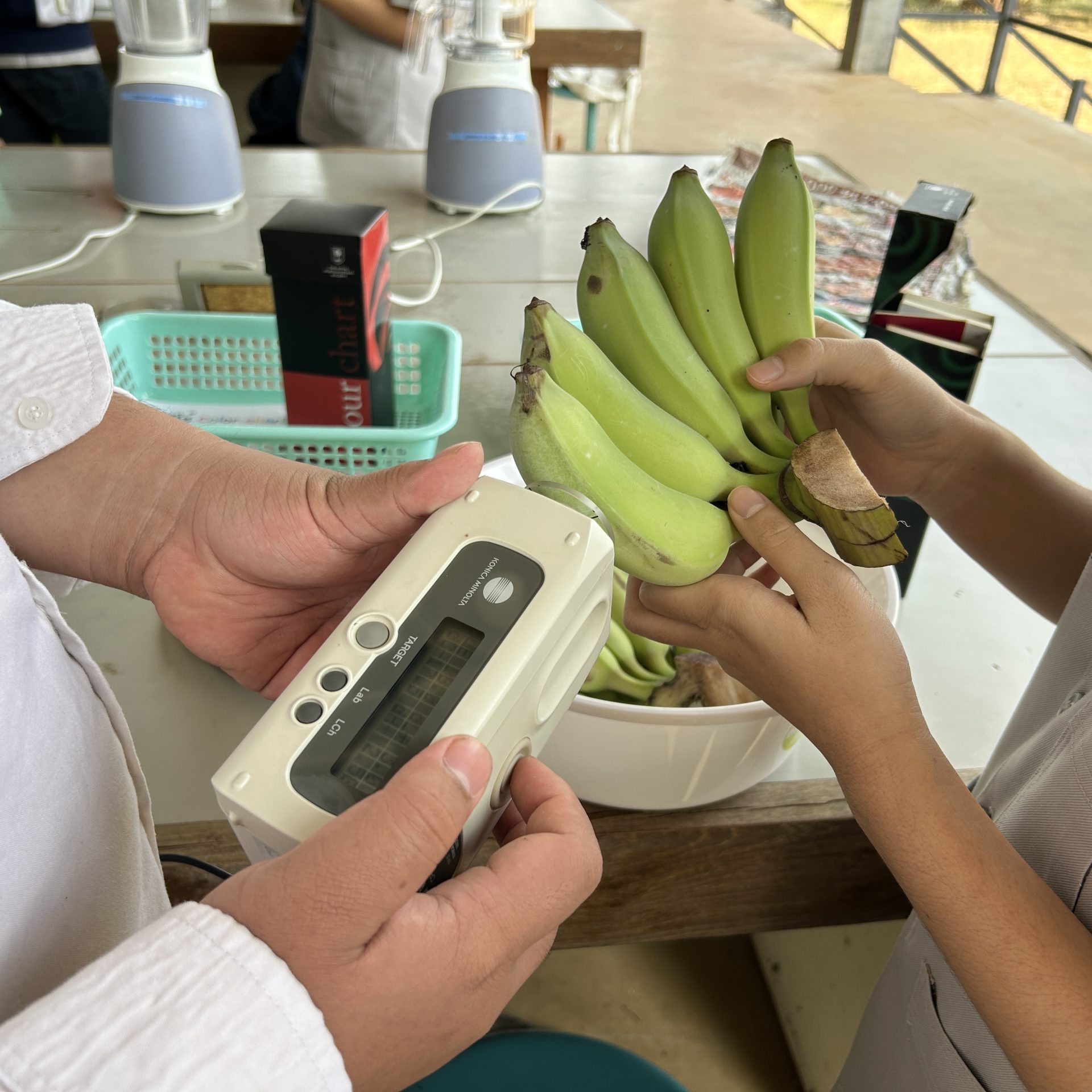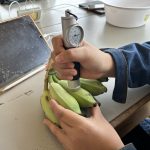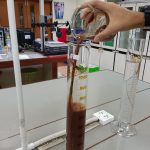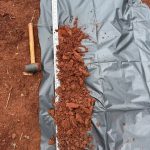The Kanchanaburi Campus of Mahidol University offers 7 undergraduate programs in Accounting, Business Administration, Agricultural Science, Conservation Biology, Food Technology, Geoscience and Environmental Engineering and Disaster Management. Admission system of the students is operated according to the policy of Thai University Central Admission System (TCAS), which was launched four years ago and set by Council of University Presidents of Thailand. The system of 2023 academic year consisted of four rounds of admission. The first round required students to submit their “portfolio” to be considered by universities. The second round was dubbed “quota round”, where each university allotted placements to students in specific regions or with special talents. These first two rounds involved no written exam but may require an interview under criteria set by the program committee. The third round involved a central examination with each student choosing four possible subjects without ranking their preferred order. The fourth round consisted of another central exam score consideration while each student can choose and rechoose another four subjects, which was ordered by their preferences.
Bachelor of Science Program in Agricultural Science
Education Philosophy
Administering education that focuses on learners’ acheivement by means of a learning-centered approach for self-development of knowledge, abilities, and new skills
Vision of the program
Agricultural science program is determined to be an opportunity of sufficient and efficient sustainable agriculture for food, medicine, energy crops and environment.
Programme Goals
Being a graduate of Agricultural science who is able to apply knowledge and skills of complete agricultural system with social and environmental concerns, potential in life-long learning with MU graduates’ attributes.
Mission of the program
-To produce a bachelor with morality, ethics, knowledge and skills both in depth and in integrative aspects who can apply their knowledge for country development towards internationalization with sustainable development concerns
– To establish research both national and international levels and transfer integrative knowledge based on resources in Western of Thailand for solving problems and sustainably improving local communities and the country
Program objectives
-
- Comprehensive knowledge and skills in agricultural science starting from the science of plant production, technology that increases production efficiency, Plant breeding with appropriate technology until the energy and food processing industry that does not affect the environment.
- Plan to be an entrepreneur in agricultural science, taking into account basic society, economy and environment for sustainability with awareness of morals and ethics and professional ethics.
- Communication skills, effectively showing understanding of others and planning teamwork both in the role of leader and teammates.
- Thinking analytically, researching and solving problems about agricultural science.
- Use information technology to search for information, process, and determine solutions to problems in the field agricultural science appropriately.
General Information
| Name of Study Program | Bachelor of Science Program in Agricultural Science |
| Address | Mahidol University Kanchanaburi Campus
199, Lumsum, Saiyok District, Kanchanaburi 71150 |
| Contact | Phone: (+66) -3458-5058
Website: https://ka.mahidol.ac.th/en/ |
| Year of Establishment | 2002 |
| Degree Awarded | Bachelor of Science (B.Sc.) in Agricultural Science |
| Language used | Thai/English |
| Admissions | Thai students who are proficient in English |
Education System
Two semesters per year
Academic Calendar
| 1st semester | 2nd semester | 3rd semester | |
| 1st year | August to December | January to May | June to July |
| 2nd year | August to December | January to May | June to July |
| 3rd year | August to December | January to May | |
| 4th year | August to December | January to May |
Tuition Fee
| 1st semester | 2nd semester | 3rd semester | All year | |
| 1st year | 18,000 Baht | 18,000 Baht | 9,000 Baht | 45,000 Baht |
| 2nd year | 18,000 Baht | 18,000 Baht | 9,000 Baht | 45,000 Baht |
| 3rd year | 18,000 Baht | 18,000 Baht | 36,000 Baht | |
| 4th year | 18,000 Baht | 18,000 Baht | ||
| Total | 72,000 Baht | 54,000 Baht | 18,000 Baht | 144,000 Baht |
Study Period
The duration of study is usually 4 years with a maximum of 8 years to complete the degree.
- Total credits No fewer than 120 credits
Graduation Requirments
- Have good behavior suitable for the prestige of the degree.
- Pass all courses and fulfill other criteria indicated in the curriculum
- Have CUM-GPA of at least 2.00
- Undergraduate students shall pass English proficiency test(s) according to the university’s conditions and regulation
Curriculum Structure
| Category | Credits |
| 1. General education courses | 24 |
| 1.1 Core general education courses | 11 |
| 1.2 Selected general education courses | 13 |
| 2. Specialized courses | 90 |
| 2.1 Basic mathematics and science subjects | 23 |
| 2.2 Core | 24 |
| 2.3 Professional courses | 17 |
| 2.3 Professional elective courses | 26 |
| 3. Free elective courses | 6 |
| TOTAL | 120 |
Study Plan
1st year
The 1st Semester
| Course Code | Title | Number of Credits
(Theory-Practice-Self-study) |
| MUGE 100 | General Education for Human Development | 3 (3-0-6) |
| KAAG 103 | Introduction to Agricultural Science | 2 (2-0-4) |
| KAGE 102 | The World of Bioresource Technology | 2 (2-0-4) |
| General Education | 10 | |
| Free Elective Course | 3 | |
| Total credits | 20 |
The 2nd Semester
| Course Code | Title | Number of Credits
(Theory-Practice-Self-study) |
| MUGE 100 | General Education for Human Development | – |
| KAAG 104 | General Chemistry for Agricultural Science | 2 (2-0-4) |
| KAAG 105 | Mathematics for Agricultural Science | 2 (2-0-4) |
| SCBI 125 | General Biology II | 3 (3-0-6) |
| SCBI 104 | Biology Laboratory II | 1 (0-3-1) |
| General Education | 9 | |
| Free Elective Course | 3 | |
| Total credits | 20 |
The 3rd Summer
| Course Code | Title | Number of Credits
(Theory-Practice-Self-study) |
| KAAG 262 | Field Trip for Agricultural Science | 1 (0-3-1) |
| Elective Course | 6 | |
| Total credits | 7 |
2st year
The 1st Semester
| Course Code | Title | Number of Credits
(Theory-Practice-Self-study) |
| KAID 280 | General Physics for Agricultural Science | 4 (4-0-8) |
| KAAG 208 | Genetic for Agriculture | 2 (2-0-4) |
| KAAG 215 | Science and Technology of Economic Crop Production | 3 (2-3-5) |
| KAAG 228 | Industrial Crop Science for Energy | 2 (2-0-4) |
| KAAG 264 | Analytical Chemistry for Agricultural Science Laboratory | 2 (1-3-3) |
| Elective Course | 6 | |
| Total credits | 19 |
The 2nd Semester
| Course Code | Title | Number of Credits
(Theory-Practice-Self-study) |
| KAID 270 | Introduction to Statistics | 2 (2-0-4) |
| KAAG 204 | Organics and Biochemistry for Agricultural Science | 4 (3-3-7) |
| KAAG 223 | Science and Technology of Economic Animal Production | 3 (2-3-5) |
| Elective Course | 6 | |
| Total credits | 18 |
The 3rd Summer
| Course Code | Title | Number of Credits
(Theory-Practice-Self-study) |
| Elective Course | 6 | |
| Total credits | 6 |
3st year
The 1st Semester
| Course Code | Title | Number of Credits
(Theory-Practice-Self-study) |
| KAID 370 | Experimental Designs | 3 (3-0-6) |
| KAAG 318 | Physiology in Crop Production | 2 (2-0-4) |
| KAAG 334 | Soil Science | 2 (2-0-4) |
| KAAG 337 | Microbiology for Agricultural Science | 3 (2-3-5) |
| KAAG 335 | Principles of Integrated Pest Management | 3 (2-3-5) |
| KAAG 363 | Practical Study of Agricultural Science for plant Production I | 1 (0-3-1) |
| KAAG 373 | Seminar I | 1 (1-0-2) |
| Total credits | 15 |
The 2nd Semester
| Course Code | Title | Number of Credits
(Theory-Practice-Self-study) |
| KAAG 319 | Plant Breeding | 3 (2-3-5) |
| KAAG 346 | Posthavest Technology | 2 (1-3-3) |
| KAAG 347 | Alcohol and Biodiesel Production Technology | 3 (2-3-5) |
| KAAG 386 | Regulation and Laws in Agricultural System | 2 (2-0-4) |
| KAAG 375 | Seminar II | 1 (1-0-2) |
| Electives | 3 | |
| Total credits | (13-14) |
4st year
The 1st Semester
| Course Code | Title | Number of Credits
(Theory-Practice-Self-study) |
| KAAG 466 | Training | 1 (0-3-1) |
| KAAG 474 | Senior Project | 4 (0-12-4) |
| Total credits | 5 |
The 1st Semester (Cooperative Education)
| Course Code | Title | Number of Credits
(Theory-Practice-Self-study) |
| KAAG 467 | Training | 6 (0-18-6) |
| Total credits | 6 |
Course Description
| MUGE 100 | General Education for Human Development | 3 (3-0-6) |
| Well-rounded graduates, key issues affecting society and the environment with respect to one’ particular context; holistically integrated knowledge to identify the key factors; speaking and writing to target audiences with respect to objectives; being accountable, respecting different opinions, a leader or a member of a team and work as a team to come up with a systematic basic research-based solution or guidelines to manage the key issues; mindful and intellectual assessment of both positive and negative impacts of the key issues in order to happily live with society and nature | ||
| KAGE 102 | The world of bioresource technology | 2 (2-0-4) |
| Definition and importance of biological resources; Technology for plant improvement and propagation; Plant disease and insect pest; Microorganisms for agriculture; New economic crop; Climate change; Human and environment; Biorefinery; Bio economy; Circular economy; Green economy; Future foods; Concerns about bioresource degradation and environmental crisis; Bioresource technology for sustainable production and consumption
|
||
| KAAG 104 | General Chemistry for Agricultural Science | 2 (2-0-4) |
| Gases; solids; liquids; ion equilibrium; electrochemistry; chemical series periodic table: representa-tion elements: transition elements; organic and inorganic chemistry; fundamental knowledge of chemical analysis both qualitative and quantitative; calculations concentration of solution and buffer; error; accuracy; precision; statistics for analytical chemistry; chemical equilibria and electrolyte
|
||
| SCBI 125 | General Biology II | 3 (3-0-6) |
| Biodiversity and diversity status of Thailand, classification and diversity of Eubacteria, Archaea and Eukarya; reproduction, embryo development and organogenesis; animal form and function, such as food procurement and digestion, respiratory system, circulatory system, excretory system, immune system, homeostasis, hormones, and nerve system | ||
| SCBI 104 | Biology Laboratory II | 1 (0-3-1) |
| Classification of plants, invertebrates and chordates, process of development and regeneration, anatomy of frogs, hormone control and homeostasis, nervous system and control, Laboratory examination is required
|
||
| KAAG 204 | Organics and Biochemistry for Agricultural Science | 4 (3-3-7) |
| Organic chemistry in agriculture food and health, structure, classification, nomenclature, reaction in organic chemistry; steriochemistry; Isomers of organics in agriculture; alkane and cycloalkane in agriculture; alkene and cycloalkene in agriculture, alkine in agriculture; testing of organic substances, aromatic hydrocarbon and halide compounds; alcohol, phenol and ether compounds, aldehyde and ketone compounds, carboxylic and its derivative compound; amine; carbohydrate; lipid, protein, metabolism, testing biomolecule compounds; enzyme; the relationship between metabolic pathways
|
||
| KAAG 264 | Analytical Chemistry for Agricultural Science Laboratory | 2 (1-1-3) |
| Analysis skills include both quantitative and qualitative techniques such as: Titration; UV-Visible spectroscopy for molecular absorption analysis; Atomic absorption spectroscopy for atom-based absorption analysis; Atomic emission spectroscopy for atom-based emission analysis; Potentiometric ion-selective electrode-based chemi-cal analysis; pH measurement for acid-base analysis; High-performance liquid chromatography (HPLC) for liquid-based separation and analysis; Gas chromatography (GC) for gas-based separation and analysis; Sampling and sample prepa-ration techniques; Acid-base titration; Precipitation titration; Complexometric titration; Redox titration; Spectrophoto-metric instruments (covering ultraviolet-visible, visible, and measurement of atomic absorption and emission); Electro-chemical instruments (including measurement of electrical potential and electrical conductivity); Chromatographic instruments (such as gas chromatography and high-performance liquid chromatography) with a focus on safety
|
||
| KAID 270 | Introduction to Statistics | 2 (2-0-4) |
| Probability, random variables and probability distributions, mathematical expectation, special probability distributions; descriptive statistics, sampling distributions, point estimation, interval estimation; hypothesis testing, elementary use of statistical software
|
||
| KAID 280 | General Physics for Agricultural Science | 4 (4-0-8) |
| Mechanics, fluid dynamics, thermodynamics, waves, optics; quantum mechanics, and nuclear physics | ||
| KAID 370 | Experimental Designs | 3 (3-0-6) |
| Basic principles of experimental design; completely randomized design; randomized blocked design; Latin square design; factorial experiments; slit-plot experiment, SPSS program; Interpretation of the result from a statistical analysis | ||
| KAAG 103 | Introduction to Agriculture Science | 2 (2-0-4) |
| Basic knowledge in agricultural science; plant and animal productions; soil, fertilizer and water managements; integrated pest management; breeding; postharvest handling; processing for energy and foods; agriculture for medicine; agricultural biotechnology; the ornamental use of plant; agricultural extensions; agribusiness; altruism and ethics
|
||
| KAAG 215 | Science and Technology of Economics Crop Production | 3 (2-3-5) |
| Classification of economic crops, botanical characteristics, plantation, cultivation, harvest, pest management, utilization, marketing, the basic farming system, teamwork and punctuality
|
||
| KAAG 223 | Science and Technology of Economic Animal Production | 3 (2-3-5) |
| The importance of economic animals; livestocks and aquatic animals; feeds and digestion; animal husbandry; reproduction; screening; breeding; farm management; sanitation; prevention of diseases; marketing, and regulations and laws related to economic animals; altruism and ethics of animal production; teamwork; presentation of selected topics
|
||
| KAAG 228 | Industrial Crop Science for Energy | 2 (2-0-4) |
| Classification of industrial crop for alternative energy sources and sustainable energy sources, performing an objective physiology; morphology analysis on each crop such as cassava; sugarcane; oil palm; physic nut and algae; paying particular attention to the production system and the policy about alternative energy sources as well as the limitations exist in terms of extracting useable energy
|
||
| KAAG 319 | Plant Breeding | 3 (2-3-5) |
| Concepts of plant breeding; genetic inheritance; population genetic; heritability, the heterosis theory, the methods of selection; breeding of self and cross pollination crops; cytogenetic and biotechnology in plant breeding; plant mutation; altruism and ethics; teamwork principles
|
||
| KAAG 334 | Soil Science | 2 (2-0-4) |
| Soil genesis, soil properties in all terms of chemical and physical of soil; soil classification; soil management and fertilizer and its use for plant production; organics farming; soil survey and field trip; teamwork
|
||
| KAAG 347 | Alcohol and Biodiesel Production Technology | 3 (2-3-5) |
| The microbial for fermentation; flour and sugar processing to alcohol; factors affecting fermentation system; alcohol production techniques and distillation; the lipid analysis in horticulture crops for energy; the production of biodiesel; waste treatment and utilization; ethanol and biodiesel production business
|
||
| KAAG 355 | Principles of Integrated Pest Management | 3 (2-3-5) |
| The importance of plant pests; classification; epidemiology; prevention; controlling; and management of insects, mites, plant diseases, weeds, birds, rats, bats, mollusks, and integrated plant pest management; safety and environmental impacts; teamwork; presentation of selected topics | ||
| KAAG 363 | Practical Study of Agricultural Science for plant Production I | 1 (0-3-1) |
| A practice in the field of agricultural science; the knowledge of soil science and plant physiology; the basic data of the efficient plant production such as soil component; soil fertilization, and plant physiological parameters; energy crops or other interesting plants used as the plant model for the study; teamwork principles
|
||
| KAAG 386 | Regulation and Laws in Agricultural System | 2 (2-0-4) |
| Regulations and Acts related to the use of plant varieties; Act on the use of animals for scientific purposes, Pathogens and Animal Toxins Act Promotion for Scientific and Technological Professions Act; Regula-tion of Agricultural Chemicals uses, the agricultural product standards act and certification; Environmental Awareness and Conservation of Natural Resources and new regulations | ||
| KAAG 208 | Genetic for Agriculture | 2 (2-0-4) |
| Genetic material, calculations: Mendelian genetic, gene interaction, probability, molecular genetics, multiple alleles, genetic recombination, gene and chromosome structure, precision, statistics; heritability, mutation, population genetic, genetics research, applications genetic for agriculture
|
||
| KAAG 262 | Field Trip for Agricultural Science | 1 (0-3-1) |
| The visit of plant and animal production: agricultural industry: institutions involved in agricultural science: agricultural fields, flower gardens, the cultivation of medicinal plants; fertilizer manufacturing, animal farms, the production process; the agricultural industrial management; the entrepreneur mindset | ||
| KAAG 318 | Physiology in Crop Production | 2 (2-0-4) |
| Plant physiological characteristics related to crop production, photosynthesis, respiration, absorption mechanism, water and nutrient transportation; environments, water soil characteristics, light, temperature, humidity; plant hormones; plant growth and development; farm practices, irrigation, fertilization; crop yield and quality
|
||
| KAAG 337 | Microbiology for Agricultural Science | 3 (2-3-5) |
| Basic knowledge of microorganisms, particularly bacteria and fungi, regardigthe shape, structure and functions; physiology and genetics, microbial classification and taxonomy; host-microorganism interaction, control and immunity; sterilization and disinfection; importance and an application of major microorganisms in agriculture, industry, environment, and public health
|
||
| KAAG 346 | Postharvest Technology | 2 (1-3-3) |
| Classifying products under the effect of physiological, chemical, biochemical insect, and microbiological changes of crop products in post harvest: cereal crops, ornamental plants, spicy and medicinal plants, vegetables and fruits, dealing with the product management preparation and preservation before the process of packaging or other processes
|
||
| KAAG 373 | Seminar I | 1 (1-0-2) |
| Searching for modern and interesting research papers and academic papers related to agricultural science; writing references; discussion on research papers by teamwork; writing the document of selected topics and presentation of work in the seminar by using various media, using communication skills in either Thai or English | ||
| KAAG 375 | Seminar II | 1 (1-0-2) |
| Academic data retrieval; communicating, analysing, criticizing information gained from various sources; synthesize; publishing, the results of their interested topic; presenting scientific information in various forms; academic communication in English
|
||
| KAAG 466 | Training | 1 (0-3-1) |
| The study of the working processes and training in the agricultural science fields at least 120 hours or 4 weeks; an integration of the theory and practical skills related to the knowledge of agricultural science; communication skill, teamwork, ethics at work and self-responsibility
|
||
| KAAG 474 | Senior Project | 4 (0-12-4) |
| The identification of research problems; the design of experiments in agricultural science; literature review; formation of objectives and hypotheses; experiment for testing hypothesis, data collection, data analysis, final report writing; presentation, safety concerns in doing research
|
||
| KAAG 467 | Cooperative Education | 6 (0-18-6) |
| Cooperative education of students to perform their knowledge and skills as employees at public or private organizations related to agricultural science under the staff supervisor at least 16 weeks; problem solving skills; interpersonal skills; teamwork; passing at least 30 hours of cooperative study preparation and orientation; performing both regular work and research; the identification of research problems; the formation of objectives and hypotheses; the design of experiments in agricultural science; the experiment for testing the hypothesis; data collection and analysis; final report writing; presentation of the works by using various media in the seminar either with advisors or cooperative education supervisors, academic communication in English
|
||
| KAGE 260 | Administration and Organization Management | 3 (3-0-6) |
| Principles of management, the roles of managers in planning, organizing, leading, directing, motivating, communicating, coordinating and controlling in order to achieve the organization goals. Introduction to economics, demand-supply, equilibrium, elasticity and category of goods, market system in economics, production cost, national income account, economic growth, elementary finance, how to read financial statements, the important financial ratios, financial planning, investment, investment diversification
|
||
| KAID 242 | English for Project Writing and Presentation | 3 (3-0-6) |
| Using English in writing and presenting projects by integrating four language learning strategies: listening, speaking, writing, and reading in order to understand the process of project preparation such as sharing opinions, brainstorming, searching for information, collecting data and writing reports, as well as, knowing techniques to prepare for project presentations in conferences | ||
| KAID 243 | English for Research | 3 (3-0-6) |
| Grammar, vocabulary, expressions, and learning strategies in writing, reading, listening, and speaking skills in scientific and social science research contexts | ||
| KAID 240 | English for Organizational Communications | 3 (3-0-6) |
| Grammar, vocabulary, expressions, and learning strategies of four basic skills in English including speaking, listening, reading, and writing, as well as intercultural communication, being relevant to organizational communications | ||
| KAAG 205 | Principle of Art for Landscape Design | 1 (0-3-1) |
| An introduction history of art, elements of art, art in landscape design, equipment design, stationery in art works, light and shadow, color theory and painting, symbol in landscape design contour and slope presentation in landscape design project, elevation and section, perspective, basic computer application for landscape design, model in landscape design; dish garden; presentation in design project | ||
| KAAG 207 | Agricultural Extension | 3 (2-3-5) |
| Concept, principles, importance, and paradigms of agricultural extension; the role of agricultural extensionist; human resource and agricultural community development; principles of interdisciplinary agricultural extension; problem identification; community assessment; techniques and tools in agricultural extension; project writing and management; problem-solving selection; extension evaluation; case study, field trip | ||
| KAAG 209 | Mathematics for Agricultural Science II | 2 (2-0-4) |
| Ordinary differential equations, linear first order differential equations, non-linear first order differential equations, second order differential equations; systems of linear equations, systems of differential equations, matrices, determinants; modeling and simulation, applications of mathematics in agricultural science discipline
|
||
| KAAG 216 | Ornamental Plant | 3 (2-3-5) |
| The meaning and importance of ornamental plants; the classification of ornamental plants, commercial ornamental plants production and marketing; an application of ornamental plants to landscape design; field trip; discussion and presentation of ornamental plant projects
|
||
| KAAG 218 | Technology of mushroom production and processing innovations | 3 (2-3-5) |
| Biology of mushroom, nutrients requirement, diversity of mushroom, suitable factors for mushroom growth, technology of mushroom cultivation, innovations in mushroom processing, mushroom utilization and modern applications, poisonous mushroom, management of mushroom farms, mushroom pests, sustainable mushroom farming, altruism and ethics
|
||
| KAAG 224 | Plant Tissue for Agriculture | 3 (2-3-5) |
| Principal and the benefits of plant tissue culture for agriculture; preparation laboratory and indispensable tools for plant tissue culture; culture medium; plant hormone; environmental factors; cell and tissue culture technics; plant propagation; plant breeding; conservation; mutation; advance technics in plant breeding; teamwork
|
||
| KAAG 225 | Seed Science and Technology | 3 (2-3-5) |
| The science of seed science, the practical aspects of seed physiology, seed production, seed development and maturation, seed drying and storage, seed viability, vigor and dormancy and the relationship with seed technology in agriculture and horticulture; seed testing methods under the rules of the International Seed Testing Association (ISTA) performed for practical laboratories
|
||
| KAAG 226 | Pomology and Orchard Management | 3 (2-3-5) |
| Fruit crop; standpoint of cultivation; orchard management; propagation; methods of improving fruit production; harvesting and post-harvest technology and field trip; to encourage students to work as a group and join working with farmers
|
||
| KAAG 270 | Action project in agricultural organization and community | 3 (2-3-5) |
| Concept; role; importance and methods of action project for agricultural organization and community change; field experience; case study; field trip; reflections on project experience
|
||
| KAAG 283 | Thai Agricultural Wisdom | 3 (2-3-5) |
| Meaning; significance; the concept of agricultural wisdom; the wisdom of farm management, agricultural inventions; crop production and protection; livestock production; processing of agricultural products; and other areas related to agriculture; teamwork
|
||
| KAAG 284 | Agribusiness | 3 (3-0-6) |
| Concepts; role and importance of agribusiness; agribusiness system structure; agribusi-ness management; agribusiness marketing; accounting and finance in agribusiness; agribusiness model; agribusiness project analysis; agribusiness pitching; preparation of an agribusiness entrepreneur; green agricultural industry; ethics and corporate social responsibility; research methodology in agribusiness | ||
| KAAG 305 | Agricultural Machinery and Irrigation | 3 (2-3-5) |
| Principles of agricultural machinery and irrigation; engine prime mover and tractor for agriculture; soil preparation machine; planting machine; fertilizer equipment, harvester, post harvester; selection, precision; decision; the irrigation system precision farming; the support system in agriculture; teamwork
|
||
| KAAG 316 | Principle of Plant Propagation | 2 (1-3-3) |
| Vegetative and reproductive propagation; factors affecting plant propagation; the selection and preparation of stock plants; planting bed preparation, equipment and systems, cuttings, grafting and layering, acclimatization of transplants; physiology, morphology, anatomy; the growth and development of propagated parts and seeds
|
||
| KAAG 323 | Basic Animal Anatomy | 3 (3-0-6) |
| The structure of cell tissue and various organ systems such as bone-joint, muscular, nervous, endocrine, integument, special sense, gastrointestinal, urinary, reproductive, cardiovascular, and respiratory and immune systems; altruism and ethics in research; presentation of selected topics
|
||
| KAAG 324 | Basic Animal Physiology | 3 (3-0-6) |
| Functions of cell tissue and various organ systems such as bone-joint, muscular, nervous, endocrine, integument, special sense, gastrointestinal, urinary, reproductive, cardiovascular, and respiratory and immune systems; altruism and ethics in research; presentation of selected topics
|
||
| KAAG 334 | Landscape Design | 3 (2-3-5) |
| Meaning, history, and styles of garden, site survey and mapping, principles of design and site planning; construction and materials in the landscape, plant material design; decorative and rock gardens, indoor and roof gardens, design of the waterfall stream and fountain; cost estimation, computer applications in landscape design, landscape maintenance; discussion and presentation of landscape design projects
|
||
| KAAG 348 | Natural Products and Their Application | 3 (2-3-5) |
| The meaning of natural products; basic biosynthetic pathway; extraction; isolation and identification of natural products; basic techniques for structure elucidation; bioassay; extraction of active compounds from medicinal plants; quality control in raw materials; business plan for natural products
|
||
| KAAG 353 | Principle of Plant Pathology and Protection | 3 (2-3-5) |
| The importance of the plant diseases, the symptoms and cause of plant diseases; microorganisms causing the disease; the disease cycle, the interaction between pathogen and host plants, epidemiology; plant disease diagnosis; principles and methods of plant disease control measures by various methods including cultural, chemical, biological, and biological agents control; safety and environmental impacts
|
||
| KAAG 354 | Agricultural Entomology and Acarology | 3 (2-3-5) |
| The identification of insects and mites, the importance of insects and mites; life history, life cycle, behaviors, habitat, host plant; economic crops of Thailand, destruction, damage, and management of insect and mite pests; safety concerns of the environment; presentation of selected topics
|
||
| KAAG 356 | Agricultural Chemicals and Biological Products | 3 (2-3-5) |
| The identification of chemical groups, biological products; mode of actions; selection of chemical groups and biological products; and application of pest management in agriculture; safety concerns of the environment; presentation of selected topics | ||
| KAAG 374 | Research Advance in Agricultural Science | 3 (3-0-6) |
| Knowledge in scientific information base, the construction of science knowledge and articles: reading and writing in collaborative group/individual; updating information, knowledge of researches advances in science e.g. agricultural science
|
||
| KAAG 384 | Computer for Agricultural Science | 3 (2-3-5) |
| Component and principles of computer operation, the computer operation system; the database management; the application software of word processor, spreadsheet and the agricultural data analysis, teamwork
|
||
| KAAG 387 | Sustainable Farming System | 3 (3-0-6) |
| The important in farm management system: purpose, plan, financial, marketing, management, and an evaluation of farm/business with responsibility, honest, moral and ethics to the sustainable farming system | ||
| KAAG 403 | Irrigation System for Agriculture | 3 (3-0-6) |
| Water resource and management; small irrigation control system; irrigation equipments; the design of open channel and the pipe irrigation systems in agricultural are, the diagnosis of the problem and solutions
|
||
| KAAG 404 | Agricultural Ecology and Biodiversity | 3 (3-0-6) |
| The relationship and elements in the agricultural area in difference contexts; the role of biodiversity in the ecosystem functioning; the importance of ecological change; biological elements to maintain the natural balance of organisms in the agricultural area; applications of ecological principles and the relationships for the sustainable agricultural ecosystem management
|
||
| KAAG 415 | Seed Science and Technology | 3 (2-3-5) |
| The science of seed science, the practical aspects of seed physiology, seed production, seed development and maturation, seed drying and storage, seed viability, vigor and dormancy and the relationship with seed technology in agriculture and horticulture; seed testing methods under the rules of the International Seed Testing Association (ISTA) performed for practical laboratories
|
||
| KAAG 418 | Soilless Culture Technology | 3 (2-3-5) |
| Producing the soilless culture for the plant production; assembling of the nutrient solution for the cultivation of various kinds of plants; selecting the proper equipment for the conducting system; the greenhouse operation and control using IT for the efficient plant production management and the commercial production plan
|
||
| KAAG 433 | Environment Issues and Management in Agricultural Area | 3 (3-0-6) |
| Environmental issue and impact in agricultural area, biodiversity change; the degradation of land, deforestation, pest problem; disposal of industrial and agricultural wastes; the sustainable management for decreasing the environment impact for agriculture
|
||
| KAAG 434 | Appropriate Technology for Resources Development | 3 (3-0-6) |
| Principles; concepts; methods; technologies; equipment supply tools for solving problems and the development of agricultural areas in suitable for the community contexts
|
||
| KAAG 447 | Agricultural Product Processing | 3 (2-3-5) |
| The process of maintain the quality of agricultural products from the origin; product harvesting, product utility and processing; innovations and technologies for value added products; market demand; the risk process analysis
|
||
| KAAG 485 | Economically Useful Insect Management | 3 (2-3-5) |
| The importance of beneficial insects; the biological control of insect pests; industrial insects; the insect farming system; Good Agricultural Practices (GAP) for cricket farming; processing; marketing at both domestic and international levels; entrepreneurial mind; teamwork; presentation of selected topics
|
||
| KAAG 487 | Agricultural Biotechnology | 3 (2-3-5) |
| Processes in biotechnology for the development; management and production of agricultural products, technologies for plant breeding and plant product development using knowledge background of plant genetics; plant breeding via genetic engineering; tissue culture of economically important plants; technology for producing animals and aquaculture; microbial biotechnology; safety and environmental impacts
|
||
| KAAG 489 | 3 (3-0-6) | |
| A study of new technology especially the application of IT as well as digital for agriculture; acquire basic knowledge of IoT; cloud computing and big data AI, an application of digital technologies to agriculture for establishing innovation and exchanging knowledge
|
||
| KAAG 490 | Creative agri- and food-innovation | 3 (3-0-6) |
| Creative thinking in an innovation for the development, management, and production for agricultural-food, appropriate recent-innovation in the improvement of products of plants; the application of innovation in agriculture and food in the country and oversea
|
||
Program learning outcomes (PLOs) and Sub program learning outcomes (SubPLOs)
| PLOs | SubPLOs |
| PLO1: Systematically solve problems in agricultural science, agricultural industry, plant and animal productions, agricultural management and related disciplines emphasizing on energy crops and industrial crops according to academic principles | 1.1) Identify the causes of agricultural problems using knowledge from general science, agriculture, society, environment, and related humanities in a systematic and context-appropriate manner
1.2) Develop appropriate plans to address agricultural science and related scientific problems based on ethics and academic integrity 1.3) Solve problems related to agricultural practices, industrial agriculture, crop and animal production, agricultural management, and related branches according to agricultural academic standards |
| PLO2: Examine and administer projects those can solve problems and organize knowledge in agricultural science | 2.1) Define the objectives of the project by analyzing data and situations accurately and relevantly.
2.2) Design the project by considering cost-effectiveness, benefits, and feasibility, in accordance with ethical and moral principles and legal requirements. 2.3) Implement the project using risk management principles, collecting accurate data based on academic standards, and achieving valuable results while considering ethics and legal principles 2.4) Summarize project outcomes accurately to fulfill the objectives according to academic standards |
| PLO3: Demonstrate agricultural practices both in the field and laboratory with concerns of academic standards and safety | 3.1) Select appropriate tools and methodologies for agricultural science operations in accordance with academic principles and aligned with objectives
3.2) Utilize tools in laboratories and agricultural fields while considering safety and risk management |
| PLO4: Communicate information to target groups successfully by using appropriate language and multimedia | 4.1) Select communication methods using language and media appropriate for the target audience
4.2) Verify the accuracy of information by referencing reliable sources according to academic standards 4.3) Exchange knowledge with the target audience in accordance with the objectives 4.4) Prepare various types of reports according to standardized academic writing formats 4.5) Present academic information in agricultural science and related branches in in accordance with objectives |
| PLO5: Work as an agricultural scientist together with people with responsibility and acceptance of diverse perspective and culture toward goal achievement of team | 5.1) Clearly define the goals of the group by considering diversity of thoughts and cultures
5.2) Develop a work plan for the group based on roles and responsibilities that are suitable for the members’ abilities 5.3) Perform tasks according to the responsibilities assigned as a group member, within the rules and agreements of the group |
| PLO6: Effectively use information technology (IT) to benefit assigned practices as an agricultural scientist | 6.1) Conduct research using information technology to develop oneself to be up-to-date
6.2) Utilize information technology to improve efficiency in agricultural science tasks while considering ethics and relevant legal requirements |
Future Careers
Occupation farmers Entrepreneurs in agriculture and other occupations in various fields the key of the organization both in the public and private sectors, in various positions as follows.
- Operator/Staff Agricultural Supervisor and Agricultural Science
- Agriculture such as Agricultural Research Officer, Agricultural Extension, Land Reform Technical Officer, Entomologist and Researchers, etc.
- Agricultural business operators.
MU Degree Profile
Admission and Screening Process for UG Prospective Students, Academic Year 2024
Round 1: Portfolio
Details of Portfolio admission and screening process for UG prospective students in academic year 2024 are as follows:
Prospective students could apply only one program or field of study. This has to be done by applying through online admission via https://tcas.mahidol.ac.th.
Round 1 Portfolio is separated into two parts. The schedules of each sub round are as follows:
- Round 1/1: From October 2, 2023 (starting from 9:30) to October 16, 2023 (until 12:00)
- Round 1/2: From December 1, 2023 (starting from 9:30) to January 8, 2024 (until 12:00)
Further details about Portfolio requirements for each program/field of study are shown in the “Entry Requirements”.
Round 2: Quota
For quota admission, prospective students could also apply only one program or field of study using online admission via https://tcas.mahidol.ac.th. The schedule for quota admission is between March 20, 2024 (starting from 9:30) and April 8, 2024 (until 12:00).
Further details about Quota requirements for each program/field of study are shown in the “Entry Requirements”.
Round 3: Central Admission
For central admission, criteria for admission for each program/field of study could be found in https://tcas.mahidol.ac.th and https://www.mytcas.com. General criteria of marking schemes for central admission includes GPAX, GAT/PAT, and common subjects developed by National Institute of Educational Testing Service (NIETS). Online admission is conducted by https://mytcas.com.
The schedule for central admission is as follows:
- Applying through online admission via https://mytcas.com starting from May 6, 2024 to May 12, 2024
- Announcing screening results of central admission for Round 3/1 at https://mytcas.com on May 20, 2024
- Confirming to be interviewed at https://mytcas.com on May 20-21, 2024
- Announcing screening results of central admission for interviewing at https://mytcas.com on May 25, 2024
- Interviewing and making medical examination on May 22-25, 2024
- Announcing lists of prospective students who pass the screening process at https://mytcas.com on June 8, 2024
Round 4: Direct Admission
For direct admission, general criteria of marking schemes for direct admission includes GPAX, GAT/PAT, and common subjects developed by National Institute of Educational Testing Service (NIETS) which the marking schemes for each program are different. Further details for each program are shown in “Entry Requirements”. Prospective students could be applied through online admission via https://tcas.mahidol.ac.th.









































